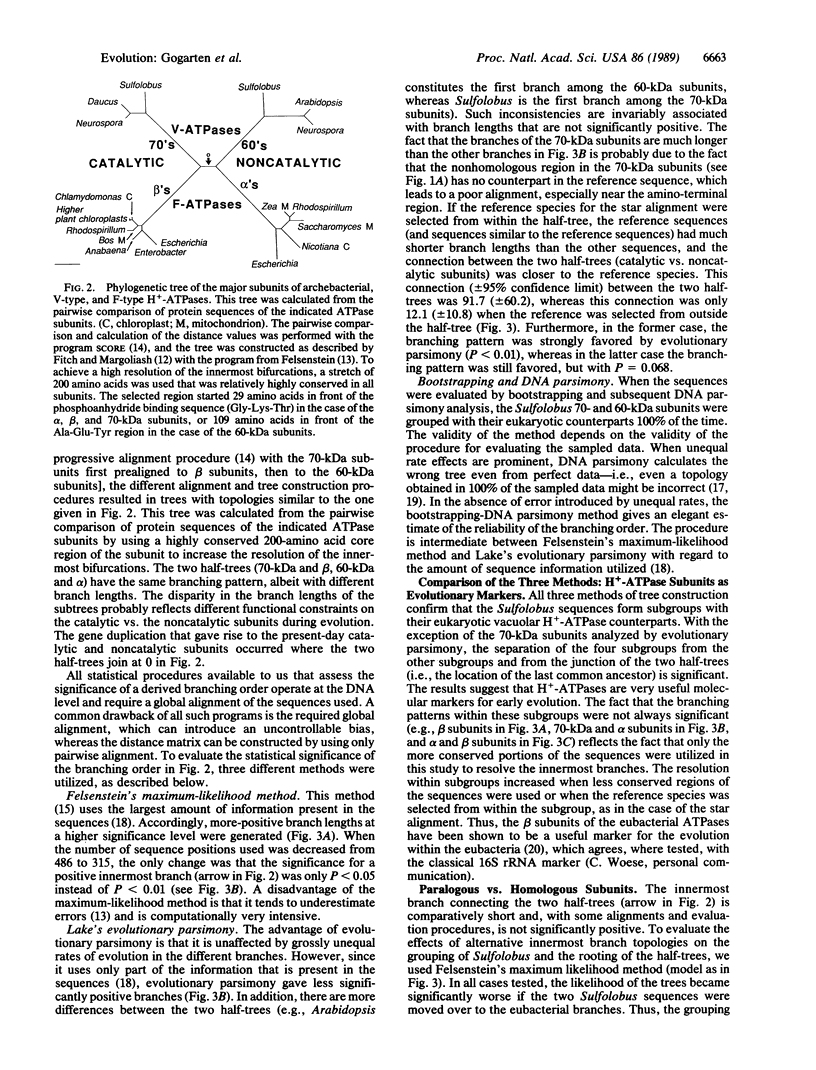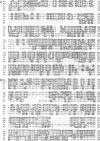Abstract
Active transport across the vacuolar components of the eukaryotic endomembrane system is energized by a specific vacuolar H+-ATPase. The amino acid sequences of the 70- and 60-kDa subunits of the vacuolar H+-ATPase are approximately equal to 25% identical to the beta and alpha subunits, respectively, of the eubacterial-type F0F1-ATPases. We now report that the same vacuolar H+-ATPase subunits are approximately equal to 50% identical to the alpha and beta subunits, respectively, of the sulfur-metabolizing Sulfolobus acidocaldarius, an archaebacterium (Archaeobacterium). Moreover, the homologue of an 88-amino acid stretch near the amino-terminal end of the 70-kDa subunit is absent from the F0F1-ATPase beta subunit but is present in the alpha subunit of Sulfolobus. Since the two types of subunits (alpha and beta subunits; 60- and 70-kDa subunits) are homologous to each other, they must have arisen by a gene duplication that occurred prior to the last common ancestor of the eubacteria, eukaryotes, and Sulfolobus. Thus, the phylogenetic tree of the subunits can be rooted at the site where the gene duplication occurred. The inferred evolutionary tree contains two main branches: a eubacterial branch and an eocyte branch that gave rise to Sulfolobus and the eukaryotic host cell. The implication is that the vacuolar H+-ATPase of eukaryotes arose by the internalization of the plasma membrane H+-ATPase of an archaebacterial-like ancestral cell.
Full text
PDF




Images in this article
Selected References
These references are in PubMed. This may not be the complete list of references from this article.
- Amann R., Ludwig W., Schleifer K. H. Beta-subunit of ATP-synthase: a useful marker for studying the phylogenetic relationship of eubacteria. J Gen Microbiol. 1988 Oct;134(10):2815–2821. doi: 10.1099/00221287-134-10-2815. [DOI] [PubMed] [Google Scholar]
- Bowman B. J., Allen R., Wechser M. A., Bowman E. J. Isolation of genes encoding the Neurospora vacuolar ATPase. Analysis of vma-2 encoding the 57-kDa polypeptide and comparison to vma-1. J Biol Chem. 1988 Oct 5;263(28):14002–14007. [PubMed] [Google Scholar]
- Bowman E. J., Tenney K., Bowman B. J. Isolation of genes encoding the Neurospora vacuolar ATPase. Analysis of vma-1 encoding the 67-kDa subunit reveals homology to other ATPases. J Biol Chem. 1988 Oct 5;263(28):13994–14001. [PubMed] [Google Scholar]
- Daniels C. J., Gupta R., Doolittle W. F. Transcription and excision of a large intron in the tRNATrp gene of an archaebacterium, Halobacterium volcanii. J Biol Chem. 1985 Mar 10;260(5):3132–3134. [PubMed] [Google Scholar]
- Denda K., Konishi J., Oshima T., Date T., Yoshida M. Molecular cloning of the beta-subunit of a possible non-F0F1 type ATP synthase from the acidothermophilic archaebacterium, Sulfolobus acidocaldarius. J Biol Chem. 1988 Nov 25;263(33):17251–17254. [PubMed] [Google Scholar]
- Denda K., Konishi J., Oshima T., Date T., Yoshida M. The membrane-associated ATPase from Sulfolobus acidocaldarius is distantly related to F1-ATPase as assessed from the primary structure of its alpha-subunit. J Biol Chem. 1988 May 5;263(13):6012–6015. [PubMed] [Google Scholar]
- Felsenstein J. Evolutionary trees from DNA sequences: a maximum likelihood approach. J Mol Evol. 1981;17(6):368–376. doi: 10.1007/BF01734359. [DOI] [PubMed] [Google Scholar]
- Feng D. F., Doolittle R. F. Progressive sequence alignment as a prerequisite to correct phylogenetic trees. J Mol Evol. 1987;25(4):351–360. doi: 10.1007/BF02603120. [DOI] [PubMed] [Google Scholar]
- Fitch W. M., Margoliash E. Construction of phylogenetic trees. Science. 1967 Jan 20;155(3760):279–284. doi: 10.1126/science.155.3760.279. [DOI] [PubMed] [Google Scholar]
- Forgac M. Structure and function of vacuolar class of ATP-driven proton pumps. Physiol Rev. 1989 Jul;69(3):765–796. doi: 10.1152/physrev.1989.69.3.765. [DOI] [PubMed] [Google Scholar]
- Fox G. E., Stackebrandt E., Hespell R. B., Gibson J., Maniloff J., Dyer T. A., Wolfe R. S., Balch W. E., Tanner R. S., Magrum L. J. The phylogeny of prokaryotes. Science. 1980 Jul 25;209(4455):457–463. doi: 10.1126/science.6771870. [DOI] [PubMed] [Google Scholar]
- Goodman M., Czelusniak J., Koop B. F., Tagle D. A., Slightom J. L. Globins: a case study in molecular phylogeny. Cold Spring Harb Symp Quant Biol. 1987;52:875–890. doi: 10.1101/sqb.1987.052.01.096. [DOI] [PubMed] [Google Scholar]
- Itoh T. Complete nucleotide sequence of the ribosomal 'A' protein operon from the archaebacterium, Halobacterium halobium. Eur J Biochem. 1988 Sep 15;176(2):297–303. doi: 10.1111/j.1432-1033.1988.tb14281.x. [DOI] [PubMed] [Google Scholar]
- Kaine B. P., Gupta R., Woese C. R. Putative introns in tRNA genes of prokaryotes. Proc Natl Acad Sci U S A. 1983 Jun;80(11):3309–3312. doi: 10.1073/pnas.80.11.3309. [DOI] [PMC free article] [PubMed] [Google Scholar]
- Kristjansson H., Sadler M. H., Hochstein L. I. Halobacterial adenosine triphosphatases and the adenosine triphosphatase from Halobacterium saccharovorum. FEMS Microbiol Rev. 1986;39:151–157. doi: 10.1016/0378-1097(86)90074-1. [DOI] [PubMed] [Google Scholar]
- Lake J. A. A rate-independent technique for analysis of nucleic acid sequences: evolutionary parsimony. Mol Biol Evol. 1987 Mar;4(2):167–191. doi: 10.1093/oxfordjournals.molbev.a040433. [DOI] [PubMed] [Google Scholar]
- Lake J. A. Origin of the eukaryotic nucleus determined by rate-invariant analysis of rRNA sequences. Nature. 1988 Jan 14;331(6152):184–186. doi: 10.1038/331184a0. [DOI] [PubMed] [Google Scholar]
- Lake J. A. Prokaryotes and archaebacteria are not monophyletic: rate invariant analysis of rRNA genes indicates that eukaryotes and eocytes form a monophyletic taxon. Cold Spring Harb Symp Quant Biol. 1987;52:839–846. doi: 10.1101/sqb.1987.052.01.091. [DOI] [PubMed] [Google Scholar]
- Manolson M. F., Ouellette B. F., Filion M., Poole R. J. cDNA sequence and homologies of the "57-kDa" nucleotide-binding subunit of the vacuolar ATPase from Arabidopsis. J Biol Chem. 1988 Dec 5;263(34):17987–17994. [PubMed] [Google Scholar]
- Mukohata Y., Ihara K., Yoshida M., Konishi J., Sugiyama Y., Yoshida M. The halobacterial H+-translocating ATP synthase relates to the eukaryotic anion-sensitive H+-ATPase. Arch Biochem Biophys. 1987 Dec;259(2):650–653. doi: 10.1016/0003-9861(87)90532-7. [DOI] [PubMed] [Google Scholar]
- Nanba T., Mukohata Y. A membrane-bound ATPase from Halobacterium halobium: purification and characterization. J Biochem. 1987 Sep;102(3):591–598. doi: 10.1093/oxfordjournals.jbchem.a122092. [DOI] [PubMed] [Google Scholar]
- Nelson H., Mandiyan S., Nelson N. A conserved gene encoding the 57-kDa subunit of the yeast vacuolar H+-ATPase. J Biol Chem. 1989 Jan 25;264(3):1775–1778. [PubMed] [Google Scholar]
- Nelson N. Structure, Function, and Evolution of Proton-ATPases. Plant Physiol. 1988 Jan;86(1):1–3. doi: 10.1104/pp.86.1.1. [DOI] [PMC free article] [PubMed] [Google Scholar]
- Olsen G. J. Earliest phylogenetic branchings: comparing rRNA-based evolutionary trees inferred with various techniques. Cold Spring Harb Symp Quant Biol. 1987;52:825–837. doi: 10.1101/sqb.1987.052.01.090. [DOI] [PubMed] [Google Scholar]
- Searcy D. G., Stein D. B., Green G. R. Phylogenetic affinities between eukaryotic cells and a thermophilic mycoplasma. Biosystems. 1978 Apr;10(1-2):19–28. doi: 10.1016/0303-2647(78)90024-2. [DOI] [PubMed] [Google Scholar]
- Woese C. R., Magrum L. J., Fox G. E. Archaebacteria. J Mol Evol. 1978 Aug 2;11(3):245–251. doi: 10.1007/BF01734485. [DOI] [PubMed] [Google Scholar]
- Zimniak L., Dittrich P., Gogarten J. P., Kibak H., Taiz L. The cDNA sequence of the 69-kDa subunit of the carrot vacuolar H+-ATPase. Homology to the beta-chain of F0F1-ATPases. J Biol Chem. 1988 Jul 5;263(19):9102–9112. [PubMed] [Google Scholar]



